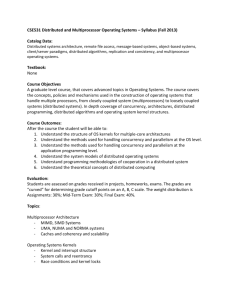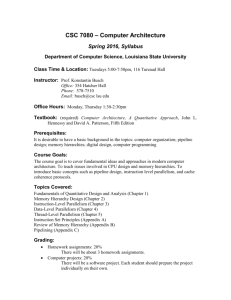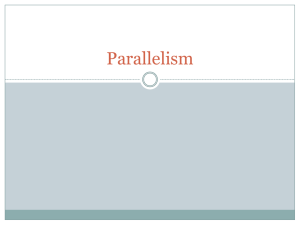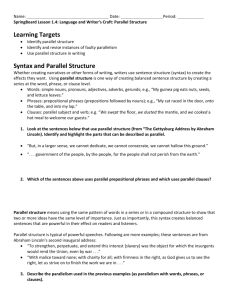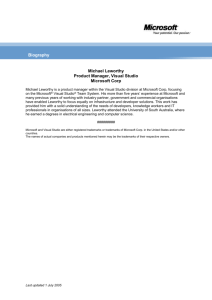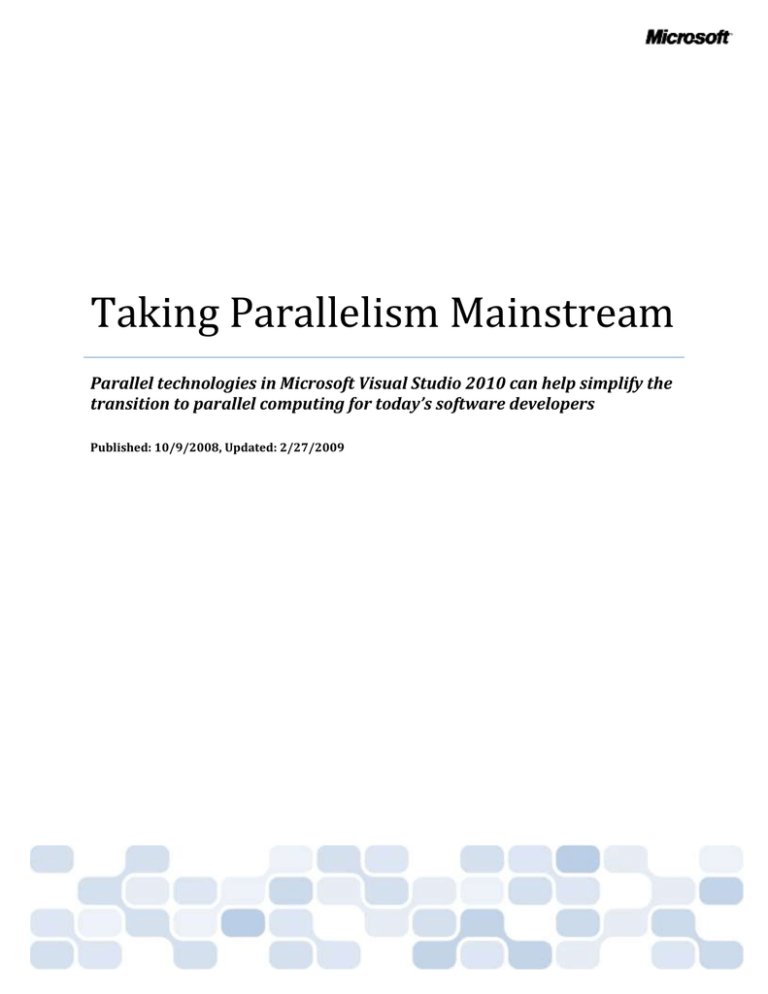
Taking Parallelism Mainstream
Parallel technologies in Microsoft Visual Studio 2010 can help simplify the
transition to parallel computing for today’s software developers
Published: 10/9/2008, Updated: 2/27/2009
Taking Parallelism Mainstream
Introduction: The Parallel Age ............................................................................................... 3
Opportunities for Parallelism ................................................................................................. 4
Challenges of Parallelism: The Hard Problems ........................................................................ 5
Expressing and Exploiting Fine-Grain Concurrency ...........................................................................5
Coordinating Parallel Access to Shared State ...................................................................................6
Testing and Debugging for Correctness and Performance ................................................................7
Solutions: Parallel Technologies and Microsoft Visual Studio 2010 ......................................... 7
Solution Overview ..........................................................................................................................7
Concurrency Runtime ...........................................................................................................................................8
Libraries ................................................................................................................................................................9
Parallel Pattern Library .....................................................................................................................................9
Asynchronous Agents Library .........................................................................................................................10
Parallel Extensions ..........................................................................................................................................10
Developer Tools ..................................................................................................................................................10
Expressing Logical Parallelism with Programming Models.............................................................. 11
Data Parallelism ..................................................................................................................................................11
Parallel Loops..................................................................................................................................................12
Parallel LINQ ...................................................................................................................................................13
Task Parallelism...................................................................................................................................................13
Parallel Invoke ................................................................................................................................................14
Tasks ...............................................................................................................................................................14
Dataflow Parallelism ...........................................................................................................................................15
Futures ............................................................................................................................................................15
Continuations .................................................................................................................................................16
Messaging Blocks and Asynchronous Agents .................................................................................................16
Using Developer Tools for Parallel Programming ........................................................................... 17
Debugging ...........................................................................................................................................................17
Parallel Tasks ..................................................................................................................................................18
Parallel Stacks .................................................................................................................................................18
Profiling ...............................................................................................................................................................18
CPU Utilization View .......................................................................................................................................18
Core Execution View .......................................................................................................................................18
Thread Blocking View .....................................................................................................................................19
Summary ............................................................................................................................. 19
More Information ................................................................................................................ 20
Taking Parallelism Mainstream
2
Introduction: The Parallel Age
Personal computing has advanced considerably in the last 30 years. Exponential growth in processing
power has transformed information management and personal productivity and has greatly expanded
the capabilities of computers. The capacity to process more data, more quickly, and with rich graphical
visualization has transformed business, science, and medicine. The capacity to render audio, video, and
three-dimensional graphics in a highly networked environment has transformed entertainment,
education, and communication. Until recently, applications like these gracefully grew faster and more
responsive, scaling with the arrival of faster processors without requiring software developers to learn
new programming paradigms.
However, the historical growth of raw sequential processing throughput has all but flattened as
processor manufacturing approaches the physical limits of the materials science involved. Moore’s Law
regarding the biennial doubling of transistor density continues, but the dividends of Moore’s Law can no
longer be applied to continued dramatic increases in clock frequency. Instead, processors are now
evolving under a new paradigm where multiple cores are placed on the same die to increase overall
processor computational horsepower. Sequential applications that had previously benefited from faster
processors do not see the same scaling as the number of processor cores grows.
The software development
industry is taking strides to
make parallelism more
accessible to all developers,
and Microsoft is helping to
lead the way.
To fully harness the scaling power of manycore systems,
applications must be redesigned, decomposed into parts
that can be computed in parallel, and distributed across
available cores. But parallelizing code is not easy today given
that the programming languages, frameworks, developer
tools, and even the majority of developers, have grown up
in a largely serial age. Today’s developers have generally
been trained to write serial code—parallel code requires a
different way of thinking about programming.
In response, the software development industry is taking
strides to make parallelism more accessible to all developers, and Microsoft is helping to lead the way.
In The Manycore Shift, Microsoft announced that it had established the Parallel Computing Initiative,
which encompasses the vision, strategy, and innovative technologies for delivering natural and
immersive personal computing experiences—harnessing the computing power of manycore
architectures.
The Microsoft® Visual Studio® 2010 development system moves this initiative forward and provides a
solid foundation for the parallel age. The significant improvements to its core platform and tools for
both native and managed applications offer developers improved confidence, simplicity, and
productivity in producing parallel applications. These innovative tools and technologies are the first
wave of the long-term commitment Microsoft has made to help developers focus on solving business
problems, scale their applications, and unlock next-generation user experiences in the face of the
manycore shift.
Taking Parallelism Mainstream
3
In this white paper, we look first at the challenges associated with parallel computing and then focus on
the Microsoft® solutions that address these challenges. We discuss how the new parallel programming
abstractions introduced in Visual Studio 2010 make it possible to develop applications and libraries with
abundant latent parallelism that scale well on today’s multi-core processors and continue to scale as
core counts increase in the future.
Opportunities for Parallelism
Parallel programming offers tremendous opportunities for scalability of both response time and
capacity. With parallelism, a single instance of a large, complex problem can often be decomposed into
smaller units and processed more quickly through the power of multiple cores working in parallel;
alternately, many problem instances can be processed simultaneously on each of the multiple cores. As
such, many “real-life” scenarios lend themselves well to parallelism, such as:
Business Intelligence (BI)
BI reporting and analysis frequently use analytical procedures that iterate against large data
models. Parallelizing these procedures—therefore distributing the work among multiple
processors—increases the responsiveness of the algorithms, producing faster reports of higher
quality. Since BI data often comes from a host of sources and business applications, using a
parallel model that aggregates the data from the multiple sources lets users access the results
more quickly. This, in turn, makes it possible for users to render data visually and to run
additional “what-if” scenarios, ultimately leading to more relevant results and timelier decisions.
Multimedia
Parallel computing can provide advantages to the next generation of multimedia processing
systems. Current multimedia applications typically rely on sequential programming models to
implement algorithms inherently containing a high degree of parallelism. Through the use
of parallel computing techniques and multi-core processors, multimedia data can be processed
by such algorithms in parallel, reducing overall processing time and enhancing user experiences.
Finance
Parallel computing can lower risk in the financial sector by giving the user faster access to better
information. For example, selecting representative stocks to mimic the performance of a larger
financial index involves intensive optimization over a large amount of historical data.
Parallelizing this process can thus provide dramatic performance gains. With parallel computing,
it is possible to look at a variety of parameters as they change over time for a given set of
financial instruments. Multiple instances of the same problem can be sent to the processing
cores; as each core finishes its current simulation, it requests another.
Consider a foreign exchange currency trader who looks for arbitrage conditions (inefficiencies in the
market) to make a profit. Such shifts are minute and quickly disappear as the market moves towards
equilibrium, making very fast trades essential. Querying stock trade information using parallelism can
Taking Parallelism Mainstream
4
enable close to real-time decision making, informed by large amounts of data and complicated analysis
and computations.
“We see a very significant
shift in what architectures
will look like in the future
... fundamentally the way
we've begun to look at
doing that is to move
from instruction level
concurrency to … multiple
cores per die. But we're
going to continue to go
beyond there. And that
just won't be in our server
lines in the future; this
will permeate every
architecture that we
build. All will have
massively multicore
implementations.”
Dr. Pat Gelsinger, Sr. VP,
Intel Corporation and GM,
Digital Enterprise Group,
February 19, 2004, Intel
Developer Forum, Spring
2004
Challenges of Parallelism: The Hard Problems
To make these scenarios possible, developers need to be able to
productively build parallel applications that can be efficiently executed and
can reliably share system resources. However, parallelism via the traditional
multithreaded programming models available today is difficult to implement
and error-prone for all but the most trivial applications.
To write effective parallel code, a developer must perform two key
functions: identify opportunities for the expression of parallelism and map
the execution of the code to the manycore hardware. Both functions are
time consuming, difficult, and prone to errors, as there are many
interdependent factors to keep track of, such as memory layout and loadbalance scheduling. Furthermore, parallel applications can be challenging to
test, debug, and analyze for functional accuracy, and they can frequently
give rise to subtle bugs and performance problems that are unique to
concurrent programs. The debugging and profiling tools that have evolved
for building applications on a single-core desktop falter when facing such
challenges in a manycore world.
Several challenges, or hard problems, must therefore be addressed before
parallelism can be deployed more widely, including:
How to express and exploit fine-grain concurrency
How to coordinate parallel access to shared state
How to test and debug for correctness and performance
Expressing and Exploiting Fine-Grain Concurrency
The concurrency motivated by the manycore shift takes a single logical task and decomposes it into
independent computations (subtasks), which can then be processed by the multiple processing cores.
The basic function of the programming languages is then to describe tasks based on sequencing of
subtasks. The opportunity to specify the concurrent execution of subtasks is a new programming
paradigm; therefore, it requires a fundamental change in programming methodology. We call this “finegrain concurrency” to highlight this deep change from other uses of concurrency such as managing
asynchronous I/O.
Writing programs that express and exploit fine-grain concurrency is inherently more difficult than
writing sequential programs because of the extra concepts the programmer must manage and the
additional requirements parallelism places on the program. Chief among these concerns is the risk of
unintended interactions between threads that share memory (“data races”) and the difficulties of
proving that no such problems exist within a program.
Taking Parallelism Mainstream
5
To encourage code reuse and to maximize the benefits of parallelism, the programmer should ensure
that the use of parallelism internal to the component is not part of the interface specification of the
component. As new components are developed that are able to exploit concurrency, they can then
replace the older components while preserving all other aspects of their behavior from the perspective
of their use in client applications. Unstructured use of concurrency coupled with hiding parallelism in
interfaces can exacerbate the problem of avoiding race conditions.
Additionally, since each component is free to present concurrency to the system that is potentially
proportional to the size of the data (or other problem parameter), a hardware system might be presented with more—possibly much more—concurrency than is needed to utilize the available resources.
The developer (or application) must then be able to manage competing demands from the various
components on the execution resources available, in addition to minimizing the overhead from any
excess concurrency.
Coordinating Parallel Access to Shared State
A second hard problem for parallel programmers involves managing the shared variables manipulated
by the tasks within an application. Programmers need better abstractions than what is currently
available to coordinate parallel access to application state; they also need better mechanisms to
document and constrain the effects of functions with respect to application state. Incorporating the
patterns of parallel computing into popular programming languages, such as C++, C#, and Microsoft®
Visual Basic®, is not easy. Simply augmenting the languages with synchronization mechanisms like locks
and event variables introduces new categories of errors not present in the base language (for example,
deadlock and unintended dependence on the interleaving of accesses to shared state).
Any solution to the parallel computing problem must address three distinct issues:
The ordering of the subcomputations. Many problems flow information through a graph
following a topological order, a linear ordering of nodes in which each node comes before all
nodes to which it has outbound edges. It is most natural to think of the concurrency in this
problem as operators applied to all nodes subject to ordering constraints determined by the
edges. Because there is no language support for this kind of pattern, developers today must
resort to very low-level mechanisms.
The collection of unordered updates to shared state. There are two key properties needed to
support shared memory programming: atomicity, in which a transaction either executes to
normal completion or has no effect on shared state, and isolation, in which the intermediate
values in the shared state cannot be witnessed by nor modified by another transaction.
Developers need to be able to provide these attributes; this lets them reason about the state of
invariants based on the sequential effects of the code within a transaction, rather than on the
various possible interleaving with other threads of control. Addressing this issue also provides
support for a hard problem shared with sequential coding: recovering from exceptional
conditions by restoring system invariants to allow continued processing.
The management of shared resources. Frequently, there are shared pools of “buffers” that
either represent real physical resources or virtual resources that are expensive to create; it is
Taking Parallelism Mainstream
6
beneficial to have a bounded number of them shared as needed by subtasks within an
application. Developers need to be able to manage these shared resources.
Testing and Debugging for Correctness and Performance
A third hard problem is testing and debugging for correctness and performance. Concurrency puts
additional demands on all stages of the application life cycle. Schedule-dependent results can potentially
increase the space of possible executions exponentially, undermining the normal tools for coveragebased testing. Concurrency cripples the basic debugging technique of tracing backwards from failure and
using repeated execution with incremental analysis of state to lead the developer to the fault. A further
complication is the much larger control state of the system. With potentially hundreds of subtasks in
progress, there is no clear definition of exactly “where” the program is or what its state should be at
that point.
Parallel computing also introduces new dimensions to the problem of analysis and tuning of program
performance, at the same time putting new emphasis on this problem. In addition to simple operation
count, a parallel programmer must now worry about the amount of concurrency presented, the
overhead associated with that concurrency, and the possibility of contention when concurrent activities
must coordinate access to shared data. These are all new problems not faced by sequential
programmers.
Solutions: Parallel Technologies and Microsoft Visual Studio 2010
The transition to parallel programming mandated by the manycore shift presents both an opportunity
and a burden to both developers and businesses. Without improved tools and technologies, developers
may find they must deal more in the microcosm of creating parallel code than on the macrocosm of
creating business value. The time that may have been spent in creating new user experiences may be
siphoned off to solve concurrency issues. This reduces developer productivity and marginalizes their
impact on a business’ bottom line.
In response, Microsoft delivers a solution with Visual Studio 2010, which draws on four goals:
Offload the complexity of writing parallel code from developers to help them focus on solving
business problems, thereby increasing their productivity.
Simplify the process of writing robust, scalable, and responsive parallel applications.
Take a comprehensive solution-stack approach, providing solutions which span from local to
distributed computing and from task concurrency to data parallelism.
Address the needs of both native and managed developers.
Solution Overview
Microsoft Visual Studio 2010 confronts the hard problems of parallel computing with higher-level
parallel constructs and abstractions that minimize the footprint on code and lower the conceptual
barriers that complicate parallel development—helping developers express logical parallelism and map
it to physical parallelism. Visual Studio 2010 also includes advanced developer tools that understand
Taking Parallelism Mainstream
7
these constructs and provide debugger and profiler views that align with the way the parallelism is
expressed in code. Figure 1 shows the parallel technologies included in Visual Studio 2010.
We begin with an overview of the solution components and then look at how they can be used.
Figure 1 The Microsoft solution
Concurrency Runtime
Microsoft addresses the challenge of mapping the execution of code to the available multi-core
hardware with the Concurrency Runtime, a standard runtime infrastructure that is well suited for the
execution of fine-grained parallelism. The runtime has different concrete manifestations in managed
and native scenarios, but its role is the same—to map logical concurrency to physical concurrency within
a process. As work is queued for execution, the Concurrency Runtime balances the workload and assigns
work across threads and processors.
To write parallel applications, a developer must both identify opportunities for parallelism and map the
execution of the code to the hardware. These functions are challenging. With Windows® multithreading,
developers must perform both of these functions independent of their counterparts—frequently in ad
hoc, component-specific ways.
Taking Parallelism Mainstream
8
The Concurrency Runtime schedules tasks and manages resources, making it easier for developers to
manage the physical underlying hardware platform. The Concurrency Runtime reduces the number of
concepts exposed to developers so they can focus on building innovative and immersive user
experiences, enabled by the processing power of manycore architectures.
With the Concurrency Runtime, the system handles the load balancing instead of leaving it to the
developer. It allows the system to adjust available resources among competing requests dynamically,
enabling external notions of priority and quality-of-service to be applied.
The Concurrency Runtime enables higher-level programming models such as the Parallel Pattern Library.
Other programming models and libraries can directly target the Concurrency Runtime to take advantage
of its extensive capabilities and to work with any other parallel frameworks used in the same
application.
Third-party parallel technologies can use the Microsoft Concurrency Runtime as a common resource
management and scheduling infrastructure on the Windows platform; third-party vendors can build on
top of the Concurrency Runtime to provide their own interoperable solutions.
Libraries
For constructing and executing parallel applications, Visual Studio 2010 includes new libraries for
developing managed applications and for developing native applications with C++:
Parallel Pattern Library
Asynchronous Agents Library
Parallel Extensions to the Microsoft® .NET Framework
Parallel Pattern Library
The Parallel Pattern Library (PPL) provides a parallel programming model abstraction for C++, making it
easier for developers to build parallel components. The PPL exposes higher-level parallel constructs to
native applications in the style of the Standard Template Library (STL) and takes advantage of features of
the proposed C++0x language standard, such as lambda expressions. The PPL uses the Microsoft
Concurrency Runtime to ensure the efficient and scalable use of system resources, and the PPL uses
additional new support in the C Runtime Library (CRT) to ensure the proper propagation of exceptions.
The library includes:
Concurrency Primitives and Algorithms. A set of C++ primitives that provide high-level
parallelism constructs for fine-grained parallel tasks. This includes parallel looping primitives,
reduction primitives, and task primitives, which are an abstraction over threads.
Concurrency Containers. A set of C++ containers that are building blocks for building parallel
components including common synchronization primitives and data structures.
The PPL is primarily targeted at enterprise developers and independent software vendors (ISVs) who
have existing investments in C++ applications and also at developers writing new C++ applications who
want to introduce parallelism into these applications. One of the most common scenarios is the efficient
parallelization of looping constructs, such as for and for_each loops. Another is the parallelization of
Taking Parallelism Mainstream
9
complex and computationally intensive algorithms by utilizing fine-grained tasks.
Asynchronous Agents Library
The Asynchronous Agents Library is a C++ template library that provides a high-level actor-based
programming model and in-process message passing for fine-grained data flow and pipelining tasks. It
includes:
Asynchronous Agents. At design time, the actor based agent helps concurrent application
development by encouraging developers to remove shared state and rely on message passing
for communicating state changes. This has the side-effect of enabling better scalability by
reducing the contention on shared state.
Messaging Blocks: These enable the developer to coordinate state changes and realize
additional concurrency within a process by building data flow pipelines of computations that are
triggered by sending messages between the pipeline stages. Additional concurrency can be
realized by using finer grained constructs from the Parallel Pattern Library within each stage of
the pipeline.Concurrency Runtime.
“The need to develop
code that runs effectively
in multi-core
environments is bringing
a new set of challenges to
the software developers.
As processor core counts
continue to increase over
time, we need to work as
a community to ensure
the software
development ecosystem
evolves to exploit this
new hardware reality.”
Earl Stahl, VP, Software
Development, AMD
Parallel Extensions
Parallel Extensions to the .NET Framework is an addition to the core
libraries of the Microsoft .NET Framework that exposes higher-level
parallel constructs to managed applications. It includes:
Parallel LINQ. A declarative model for data parallelism based on
Language Integrated Query (LINQ).
Task Parallel Library (TPL). An imperative model for both task and
data parallelism based on explicit parallel patterns, such as tasks and
futures, and parallel constructs, such as Parallel.For.
Coordination Data Structures (CDS). A set of coordination and
synchronization building blocks that simplify common communication
and initialization patterns.
Parallel Extensions is targeted at developers using managed code (any
.NET language, such as C#, Visual Basic, C++/CLI, and F#). Parallel
Extensions makes it easy to automatically parallelize LINQ-to-Objects
queries, empowering developers to achieve significant speedups with
very few modifications to their existing and new code bases. The Task Parallel Library makes it similarly
easy to introduce data and task parallelization into an application, whether through the parallelization of
looping constructs or through the parallelization of more complicated algorithms utilizing fine-grained
tasks
Developer Tools
A key component of the Microsoft Parallel Computing Initiative is to simplify the construction of parallel
applications by offering tools that let code developers manage the complexity, non-determinism, and
asynchronicity inherent in parallel software. Microsoft provides diagnostic and optimization tools that
Taking Parallelism Mainstream
10
operate at the same level of abstraction that developers use
to write their code; this empowers them to understand the
complex program state information associated with many
concurrent activities, and it provides enhanced performance
analysis functionality so developers can optimize software
performance on multi-core hardware.
Microsoft Visual Studio 2010
introduces new, higher-level
programming models that
disentangle parallel
specification from physical
implementation.
Microsoft has added new debugging toolwindows to Visual
Studio 2010 that support task models in addition to
traditional threading programming models. Visual Studio
2010 also includes profiling tools, which let developers
analyze their parallel applications to measure the degree of parallelism within an application, discover
contention for resources across the system, visualize thread distribution across cores, and drill into how
much time is spent within the application executing program code versus waiting on synchronization
objects, performing I/O, and more.
Expressing Logical Parallelism with Programming Models
We now look at how developers can use the new programming models in Visual Studio 2010 to express
logical parallelism, creating robust and efficient parallel applications.
Traditional multithreaded programming techniques require that developers not only define where
concurrency is possible but also how that concurrency is to be achieved (such as through explicit thread
management). With these techniques, concurrency is mandatory; parallelism will be used even if it is to
the detriment of overall program performance.
Visual Studio 2010 introduces new, higher-level programming models for concisely expressing fine-grain
concurrency, disentangling the parallel specification from the physical implementation. These models
enable developers to invite (rather than demand) concurrent execution of their code. They rely on the
Concurrency Runtime to efficiently schedule and execute their code on available cores.
Visual Studio 2010 supports three major models for expressing logical parallelism:
Data parallelism
Task parallelism
Dataflow parallelism
Data Parallelism
We now consider the following problem:
Given an end-of-day market report for all stocks trading on the NASDAQ, find all stocks with
market capitalization greater than USD $100B whose closing prices fell by more than 2.5 percent
on volume 5 percent greater than average.
Taking Parallelism Mainstream
11
Here is what a sequential solution in C# might look like:
IEnumerable<StockQuote> Query(IEnumerable<StockQuote> stocks) {
var results = new Queue<StockQuote>();
foreach (var stock in stocks) {
if (stock.MarketCap > 100000000000.0 &&
stock.ChangePct < 0.025 &&
stock.Volume
> 1.05 * stock.VolumeMavg3M) {
results.Enqueue(stock);
}
}
return results;
}
This problem is composed of subproblems that are independent of each other and can be executed
concurrently. In this example, the subproblems are defined by data decomposition and the unit of
parallelism is an individual quote from the set of all stock quotes. The program here applies the same
query function over each stock quote.
Visual Studio 2010 provides two techniques for expressing this type of data parallelism:
Parallel loops
Parallel LINQ
Parallel Loops
The parallel loops approach replaces for and foreach loops with explicit parallel loop constructs. For
example:
IEnumerable<StockQuote> Query(IEnumerable<StockQuote> stocks) {
var results = new ConcurrentQueue<StockQuote>();
Parallel.ForEach(stocks, stock => {
if (stock.MarketCap > 100000000000.0 &&
stock.ChangePct < 0.025 &&
stock.Volume
> 1.05 * stock.VolumeMavg3M) {
results.Enqueue(stock);
}
});
return results;
}
The principal difference between this and the sequential version above is that the foreach keyword has
been replaced with a call to Parallel.ForEach and the body of the loop has become a lambda
expression. An additional difference is the use of a thread-safe ConcurrentQueue<T> (found in the new
System.Collections.Concurrent namespace of the .NET Framework 4.0) instead of a Queue<T>. Such
constructs are provided for both managed (via Parallel Extensions to the .NET Framework) and native
(via the Parallel Pattern Library) applications.
A native application, such as one performing matrix multiplication, can replace a for loop with a call to
the parallel_for template function. Here is what the sequential code looks like:
Taking Parallelism Mainstream
12
void MatrixMult(int size, double** m1, double** m2,double** result){
for (int i = 0; i < size; i++){
for (int j = 0; j < size; j++){
double temp = 0;
for (int k = 0; k < size; k++) {
temp += m1[i][k] * m2[k][j];
}
result[i][j] = temp;
}
}
}
A possible parallel version looks like this:
void MatrixMult(int size, double** m1, double** m2,double** result){
parallel_for (0,size,1,[&](int i){
for (int j = 0; j < size; j++){
double temp = 0;
for (int k = 0; k < size; k++) {
temp += m1[i][k] * m2[k][j];
}
result[i][j] = temp;
}
});
}
This example also uses a lambda expression to automate the work of manually creating a function and
capturing the variables used in the function.
Parallel LINQ
If the method is defined using LINQ in managed code, an even easier approach is provided; just add
AsParallel to any enumerable collection:
IEnumerable<StockQuote> Query(IEnumerable<StockQuote> stocks) {
return from stock in stocks.AsParallel()
where stock.MarketCap > 100000000000.0 &&
stock.ChangePct < 0.025 &&
stock.Volume
> 1.05 * stock.VolumeMavg3M
select stock;
}
The AsParallel extension method binds any enumerable collection to Parallel LINQ (PLINQ). PLINQ
analyses the query, partitions the work to multiple processor cores to share the work, and yields a
merged result. This provides performance and scalability improvements over many LINQ queries.
Task Parallelism
Where the stock search problem implicitly created a number of tasks (where each task was involved in
processing a distinct subset of all quotes), other problems are better expressed by explicit specification
of tasks. One such problem is a common building block found in many multimedia algorithms for
processing images, video, and sound: discrete Fourier transforms (DFT). An efficient algorithm for
computing a DFT is a fast Fourier transform (FFT), and a common implementation of an FFT recursively
Taking Parallelism Mainstream
13
decomposes a DFT into multiple smaller DFTs. Such an FFT is a specific example of a divide-and-conquer
problem, others of which include visiting all of the nodes of a binary tree or sorting via the quicksort
algorithm. The subproblems created by dividing the parent problem are often independent of each
other and can be executed concurrently.
Microsoft Visual Studio 2010 provides two techniques for this kind of task parallelism:
Parallel Invoke
Tasks
Parallel Invoke
The Parallel Invoke construct lets the developer explicitly invite concurrent invocation of several actions.
For example, in this naïve C++ implementation of quicksort, the algorithm partitions the array to be
sorted and then recursively calls itself to sort each partition:
void quicksort(int * a, int n) {
if (n <= 1) return;
int s = partition(a,n);
quicksort(a,s);
quicksort(a+s,n-s);
}
This can be parallelized with only a minor change:
void quicksort(int * a, int n) {
if (n <= 1) return;
int s = partition(a,n);
parallel_invoke(
[&]{quicksort(a,s);},
[&]{quicksort(a+s,n-s);});
}
The recursive calls to quicksort are wrapped up in lambda expressions, and the expressions are passed
to parallel_invoke. As with the parallel looping constructs, this construct is available to both managed
and native applications.
Tasks
All of the constructs demonstrated so far are higher-level constructs that help the developer create finegrained tasks under the hood. In fact, these constructs employ another, slightly lower-level set of
constructs called tasks. Provided by both Parallel Extensions to the .NET Framework and the Parallel
Pattern Library, these task constructs make it possible for developers to create and manage individual
tasks (as well as groups of tasks) while still capitalizing on the concurrency runtime for task scheduling
and execution.
The quicksort example above can be modified to explicitly use tasks:
void quicksort(int * a, int n) {
if (n <= 1) return;
int s = partition(a,n);
Taking Parallelism Mainstream
14
task_group g;
g.run([&]{quicksort(a,s);});
g.run([&]{quicksort(a+s,n-s);});
g.wait();
}
This example is functionally equivalent to the version that uses parallel_invoke. However, the explicit
use of tasks permits more complex orchestration of actions than can be achieved with higher-level
constructs like parallel invoke.
Dataflow Parallelism
Some parallel programming problems can be greatly simplified by creating structure around the sources
of parallelism and by specifying the computation structure separately from the processing of the
individual elements. This structure can take the form of dependencies (specifying, for example, that a
value or operation depends upon the availability of other values or the completion of other operations)
or of message protocols (specifying that operations make progress in response to sending and receiving
coordinated messages).
Consider a business intelligence (BI) scenario where customer data previously entered through kiosks is
streamed into an application for processing. In order to limit bad entries entering the application, data
mining techniques are used to provide a confidence level as to whether a particular customer record is
likely valid or should be filtered out. Entries that make it through the screening are passed along to the
next stage for additional processing. Such a pipeline is a prime example of dataflow parallelism. Stages
in the pipeline may be executed concurrently on discrete data points (e.g. one customer record being
validated while the next record is being loaded), and multiple data points may be processed in parallel
by applicable stages (e.g. two customer records being validated at the same time).
Microsoft Visual Studio 2010 provides three ways to express dataflow parallelism:
Futures
Continuations
Messaging blocks and asynchronous agents
Futures
Futures are a higher-level programming construct that helps developers define tasks that will produce
values. Futures refer to an object that acts as a proxy for a result that is not yet known, usually because
the computation of its value has not yet completed.
An example can be found in the pricing of stock options. The prices of the stocks are generated from a
function (which may, for example, retrieve prices via a Web service) and encapsulated as futures. These
futures are effectively tasks that, by contract, return a value. When the result value is needed, the caller
retrieves the Result property of the future. If the operation producing the value has completed, the
property will return the value immediately. If not, the caller waits until the value is available and may
even assist in the computation of the result if applicable.
Taking Parallelism Mainstream
15
The operation encapsulated by a future can depend on the value of other futures. For example, the
price of an option may depend on the price of one or more underlying instruments, each of which may
depend on retrieving data from a network service or calling into a compute-intensive library. Futures
can help model this scenario as a parallel dataflow. In the Task Parallel Library, a future is represented as
a Task<TResult>.
The following code implements this example by generating a dictionary of stock prices that can be used
for pricing options:
var symbols = new [] { "MSFT", "INTL", "AAPL", "GOOG" };
var prices = new Dictionary<string, Task<double>>(symbols.Length);
foreach(var symbol in symbols)
{
prices.Add( symbol, Task.Factory.StartNew( () => GetPrice( symbol ) ) );
}
Continuations
Continuations are another higher-level construct that give developers the ability to define operations
that will run when another operation is completed. Continuations can receive the result from their
predecessor(s), and long chains of operations can be explicitly defined in code. For example:
var c = Task.Factory.StartNew(() => A())
.ContinueWith(a => B(a.Result))
.ContinueWith(b => C(b.Result));
Tasks (both those that do and don’t return results) can be linked together with continuations.
Continuations can also be conditional, only executing upon success (or failure) of a predecessor.
Continuations may also be predicated on multiple tasks, such that the resulting task will only be
executed when any or all of the specified tasks have completed.
Messaging Blocks and Asynchronous Agents
The final form of dataflow parallelism is asynchronous agents. Asynchronous agents use messaging
blocks to synchronize and exchange data. This structure supports a data-driven style between longerlived persistent tasks, rather than the transient tasks in the examples above.
The following example uses messaging blocks and asynchronous agents to parse a file line by line. While
a typical serial implementation would combine reading the file with parsing it, in this implementation
the task of reading the file and parsing it are assigned to two distinct, concurrently executing agents. The
first agent in the listing below, the parsing agent, waits for messages to arrive from the reading agent.
The reading agent reads the file and sends each line as a message to the parsing agent, allowing for
incremental, stream-oriented processing.
HRESULT LogChunkFileParser::ParseFile(){
unbounded_buffer<AgentMessage>* MsgBuffer =
new unbounded_buffer<AgentMessage>();
// the parsing agent
AgentTask* pParserAgent = new AgentTask([&]{
Taking Parallelism Mainstream
16
AgentMessage msg;
while((msg = receive(MsgBuffer))->type != EXIT)
{
Parse(msg->pCurrentLine);
delete msg->pCurrentLine;
}
});
//start the parsing agent
pParserAgent->start();
// the reading agent
HRESULT hr = S_OK;
WCHAR* wszLine;
hr = reader->OpenFile(pFileName);
if (SUCCEEDED(hr)){
while(!reader->EndOfFile()){
wszLine = new WCHAR[MAX_LINE];
// read the next line
hr = reader->ReadLine(wszLine, MAX_LINE);
if (SUCCEEDED(hr)){
//and parse it
send(MsgBuffer, AgentMessage(wszLine));
}
}
send(MsgBuffer, AgentMessage(EXIT));
hr = agent::wait(&pParserAgent);
}
return hr;
};
The unbounded buffer template class allows the asynchronous agents to communicate with type-safe
messages using a simple send/receive metaphor.
Using Developer Tools for Parallel Programming
Visual Studio 2010 includes several enhanced tools to help developers as they transition to parallel
programming. The goals are to:
Let developers use the same nomenclature and abstractions in the tools as those used to write
code.
Let developers cope with the unique complexities of scale, non-determinism, and concurrency
that exist in the parallel world.
Debugging
All of the programming models described above use tasks, either directly or as the foundation for their
implementation. A task represents a unit of user-defined work that is ultimately executed by a thread.
Since tasks are so important to parallel programs, it does not make sense to force developers to make a
mental jump back to threads when they are debugging. Therefore, two new toolwindows are added to
Visual Studio 2010 that make tasks a first-class citizen in debugging:
Parallel tasks
Parallel stacks
Taking Parallelism Mainstream
17
Parallel Tasks
The Parallel Tasks toolwindows display the tasks created by the application and show whether they are
running, they have run and are now waiting on a resource, or they have not run yet but are scheduled to
do so. It also shows additional information such as the thread that is executing the task, the parent-child
hierarchy, and the task’s call stack. This view enables the developer to understand the system load and
current execution patterns.
Parallel Stacks
With the Parallel Stacks toolwindows, a developer can see at a glance all the call stacks for all tasks or
threads in the application. This graphical view builds on familiar concepts of the call stack window and
enhances it, not only by expanding the focus from one execution context to multiple, but also by visually
indicating which methods are shared by which tasks or threads. The graph is interactive; the developer
can use it to quickly change the focus area of debugging, and the rest of the development environment
(such as the editor and other toolwindows) will reflect the change.
The new debugger toolwindows support both managed and native task models as well as traditional
threading programming models.
Profiling
With Visual Studio 2010, developers are able to analyze their parallel applications to measure the
degree of parallelism within an application, discover contention for resources across the system,
visualize thread distribution across cores, and drill into how much time is spent within the application
executing program code versus waiting on synchronization objects, performing I/O, and more. In
particular, Microsoft Visual Studio 2010 offers three new profiler views:
CPU utilization view
Core execution view
Thread blocking view
CPU Utilization View
The CPU utilization view makes it possible for developers to determine the phases of an application that
are CPU-bound, their relative durations, and the level of system core utilization. Developers can then
zoom in on those phases and examine the forms of parallelism that exist and how they may be used.
During the performance-tuning phase, this view can confirm whether the concurrency expected is
indeed observed during execution.
Basic timing measurements can be made to estimate speed improvements achieved, compared to a
previous or sequential execution. The concurrency view also gives the developer an idea of the
interaction between the application in question and other processes in the system.
Core Execution View
The purpose of the core execution view is to show the mapping of threads to cores during a given
profiling session. This information helps a developer to conceptualize the execution of their application
over time and uncovers instances of thread migration. Thread migration occurs when a thread is moved
Taking Parallelism Mainstream
18
from one core to another and is a resource-intense operation that can impair overall application
performance. By examining thread state across the duration of the trace, the user can spot migration
and tie it back to specific delays using the thread blocking view.
Thread Blocking View
Once a phase of interest has been identified using either the CPU utilization or core execution views, the
developer can then further analyze the behavior of the application using the thread blocking view. This
view provides a wealth of information about the behavior of each thread in the application.
First, it generates a bar graph with an execution breakdown of each
“After decades of single
thread, depicting the fraction of each thread’s lifetime that was spent
core processors, the high executing code or blocking. Blocking delays are further broken down into
volume processor industry various categories, such as I/O or synchronization.
has gone from single to
Second, the view provides a timeline visualization with time on the x-axis
dual to quad-core in just
and threads and physical disk I/O as lanes on the y-axis. For disk I/O, the
the last two years.
view shows reads and writes as they occur in time on disk and shows the
Moore’s Law scaling
should easily let us hit the files being accessed. For threads, the view shows when they are
80-core mark in
executing, when they are blocked, and the category of delay, using color
mainstream processors
to convey thread state. Measurement and marker features show the use
within the next ten years of the new programming constructs made available by the managed
and quite possibly even
Parallel Extensions to the .NET Framework and native Parallel Pattern
less.”
Library. For example, an application’s use of a parallel for loop is displayed
—Justin Rattner, CTO,
on the timeline to indicate the duration of the loop in the profile trace.
Intel, February 2007,
Integrated Solid State
Third, call stack analysis lets the developer pause on any blocking
Circuits Conference
segment in the timeline view to understand in detail what each thread
was doing when it was blocked. For example, the view can show the call
stack (including source code line numbers) that resulted in a blocking attempt to acquire the critical
section. Reports can be generated that include detailed execution, blocking, and disk I/O statistics.
Summary
Future improvements to software performance will largely hinge on software being able to take
advantage of the proliferation of manycore processors through parallel computing. The software
development industry is taking strides to make parallelism more accessible and feasible for all
developers, and Microsoft is helping to lead the way. The comprehensive solution stack approach from
Microsoft addresses manycore parallelism from operating system to applications. With Visual Studio
2010, Microsoft is delivering the first wave of powerful developer solutions- including a Concurrency
Runtime and associated programming models, libraries, and tools that ease the transition to parallel
programming. These technologies will enable the development of applications and libraries with
abundant latent parallelism that will scale well on today’s multi-core processors and continue to scale as
processor core counts multiply in the future.
Taking Parallelism Mainstream
19
More Information
Callahan, D. (2008, October). Paradigm Shift: Design Considerations For Parallel Programming. Retrieved
October 9, 2008, from MSDN Magazine: http://msdn.microsoft.com/magazine/cc872852
Duffy, J., & Essey, E. (2007, October). Parallel LINQ: Running Queries on Multi-Core Processors. Retrieved
October 9, 2008, from MSDN Magazine: http://msdn.microsoft.com/magazine/cc163329
Microsoft Corporation. (n.d.). Retrieved October 9, 2008, from Parallel Programming with .NET:
http://blogs.msdn.com/pfxteam/
Microsoft Corporation. (n.d.). Retrieved October 9, 2008, from Parallel Programming in Native Code:
http://blogs.msdn.com/nativeconcurrency/
Microsoft Corporation. (2008, June 2). Microsoft Parallel Extensions to .NET Framework 3.5, June 2008
Community Technology Preview. Retrieved October 9, 2008, from Microsoft.com:
http://www.microsoft.com/downloads/details.aspx?FamilyId=348F73FD-593D-4B3C-B055694C50D2B0F3
Microsoft Corporation. (n.d.). Parallel Computing Developer Center. Retrieved October 9, 2008, from
MSDN: http://msdn.microsoft.com/concurrency/
Microsoft Corporation. (2007, November). The Manycore Shift: Microsoft Parallel Computing Initiative
Ushers Computing into the Next Era. Retrieved October 9, 2008, from Microsoft Corporation:
http://go.microsoft.com/fwlink/?LinkId=124050
Toub, S., & Shafi, H. (2008, October). Coding Tools: Improved Support For Parallelism In The Next Version
Of Visual Studio. Retrieved October 9, 2008, from MSDN Magazine: http://msdn.microsoft.com/enus/magazine/cc817396.aspx
The information contained in this document represents the current view of Microsoft Corporation on the issues discussed as of
the date of publication. Because Microsoft must respond to changing market conditions, it should not be interpreted to be a
commitment on the part of Microsoft, and Microsoft cannot guarantee the accuracy of any information presented after the date
of publication.
This White Paper is for informational purposes only. MICROSOFT MAKES NO WARRANTIES, EXPRESS, IMPLIED, OR STATUTORY,
AS TO THE INFORMATION IN THIS DOCUMENT.
Complying with all applicable copyright laws is the responsibility of the user. Without limiting the rights under copyright, no part
of this document may be reproduced, stored in or introduced into a retrieval system, or transmitted in any form or by any means
(electronic, mechanical, photocopying, recording, or otherwise), or for any purpose, without the express written permission of
Microsoft Corporation.
Microsoft may have patents, patent applications, trademarks, copyrights, or other intellectual property rights covering subject
matter in this document. Except as expressly provided in any written license agreement from Microsoft, the furnishing of this
document does not give you any license to these patents, trademarks, copyrights, or other intellectual property.
© 2009 Microsoft Corporation. All rights reserved.
Microsoft, Visual Basic, Visual Studio, and Windows are trademarks of the Microsoft group of companies.
All other trademarks are property of their respective owners.
Taking Parallelism Mainstream
20

